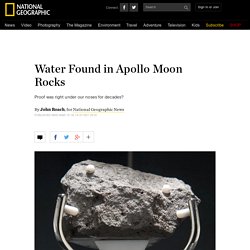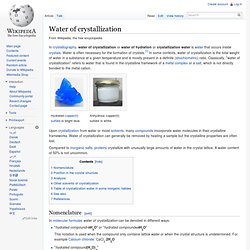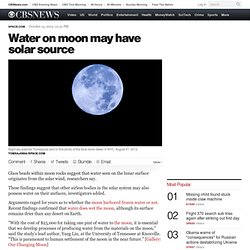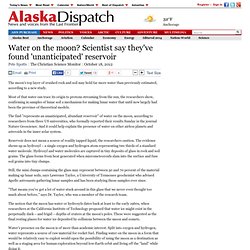

Water on the Moon. Moon Water Made by the Sun? Long thought to be bone dry, the moon has recently been confirmed as relatively water rich. But a big question remains: Where did the wet—or more accurately, icy—stuff come from? Water Found in Apollo Moon Rocks. Recently NASA crashed two spacecraft into the moon and orbiters scanned the lunar surface for telltale light signatures—all to confirm the rocky body isn't bone dry after all.

But, it turns out, solid evidence for water on the moon was under our noses the whole time. Tiny amounts of water have been found in some of the famous moon rocks brought back to Earth by the Apollo astronauts, scientists announced last Wednesday. (Related: "Apollo 11 at 40: Facts, Myths, Photos, and More. ") The water levels detected in Apollo moon rocks and volcanic glasses are in the thousands of parts per million, at most—which explains why analyses of the samples in the late 1960s and early 1970s concluded that the moon was absolutely arid.
"Only in the last decade have instruments become sensitive enough to even analyze water at those kinds of concentrations," said Gary Lofgren, the lunar curator at NASA's Johnson Space Center in Houston, Texas. (Read more about moon exploration.) Sci-Tech: Water on the moon. By Jeremy Bailey, University of New South Wales A study published in the journal Nature Geoscience last week suggests water on the moon may have come, at least in part, from the sun.

Until a few years ago the orthodox view was that the moon was bone-dry. But that view underwent a sudden change in 2009. Researchers used the Indian Chandrayan 1 spacecraft to measure sunlight reflected from the moon's surface and found absorptions at wavelengths distinctive of water (H2O) and the related molecule hydroxyl (OH). (Different materials reflect different wavelengths of light and by determining the wavelengths that are absorbed, researchers can determine which compounds – in this case water and hydroxyl – the light is reflecting off.) Marshall Solar Physics. Water of crystallization. In crystallography, water of crystallization or water of hydration or crystallization water is water that occurs inside crystals.

Water is often necessary for the formation of crystals.[1] In some contexts, water of crystallization is the total weight of water in a substance at a given temperature and is mostly present in a definite (stoichiometric) ratio. Classically, "water of crystallization" refers to water that is found in the crystalline framework of a metal complex or a salt, which is not directly bonded to the metal cation. Anhydrous copper(II) sulfate is white. Upon crystallization from water or moist solvents, many compounds incorporate water molecules in their crystalline frameworks.
Water of crystallization can generally be removed by heating a sample but the crystalline properties are often lost. Compared to inorganic salts, proteins crystallize with unusually large amounts of water in the crystal lattice. Nomenclature[edit] "hydrated compound⋅nH2O" or "hydrated compound×nH2O" Where did the water on the moon come from. Moon Made Water From Solar Wind. Scientists are still uncovering surprises in the samples Neil Armstrong brought back from the moon more than 43 years ago.

Blast some particles from the sun onto the seemingly dry moon and what do you get? Water, says a team of researchers who probed 43-year-old samples returned from the moon by Neil Armstrong and other Apollo astronauts. The finding was not really a surprise, notes lead researcher Yang Liu, with the University of Tennessee in Knoxville, but it was a long time coming. Analysis of the Apollo moon samples, which began in the 1970s, previously had uncovered the presence of hydrogen inside volcanically produced glass beads in the soil. In 2008, scientists found hydrogen in a phosphate mineral in lunar rocks, and last year found it again inside another mineral, olivine. NEWS: Inner Moon as Wet as Earth Three robotic probes, including NASA's LCROSS experiment, also have found evidence for water ice on the moon. Water particles found on surface of the moon, scientists say.
Water on moon may have solar source. Night sky watcher Tomsajinsa sent in this photo of the blue moon taken in NYC, August 31, 2012.

Tomsajinsa/Space.com Glass beads within moon rocks suggest that water seen on the lunar surface originates from the solar wind, researchers say. These findings suggest that other airless bodies in the solar system may also possess water on their surfaces, investigators added. Arguments raged for years as to whether the moon harbored frozen water or not. Recent findings confirmed that water does wet the moon, although its surface remains drier than any desert on Earth. Moon has 'unanticipated, abundant' amount of water due to the sun, scientists find.
The moon's top layer of crushed rock and soil may hold far more water than previously estimated, according to a new study.

Most of that water can trace its origin to protons streaming from the sun, the researchers show, confirming in samples of lunar soil a mechanism for making lunar water that until now largely had been the province of theoretical models. The find "represents an unanticipated, abundant reservoir" of water on the moon, according to researchers from three US universities, who formally reported their results Sunday in the journal Nature Geoscience.
And it could help explain the presence of water on other airless planets and asteroids in the inner solar system. Reservoir does not mean a source of readily tapped liquid, the researchers caution. The evidence shows up as hydroxyl – a single oxygen and hydrogen atom representing two thirds of a standard water molecule. Water on the moon? Maybe a lot more than we thought ... thanks to the sun. The moon's top layer of crushed rock and soil may hold far more water than previously estimated, according to a new study.

Skip to next paragraph Subscribe Today to the Monitor Click Here for your FREE 30 DAYS ofThe Christian Science MonitorWeekly Digital Edition. Yang liu cv.